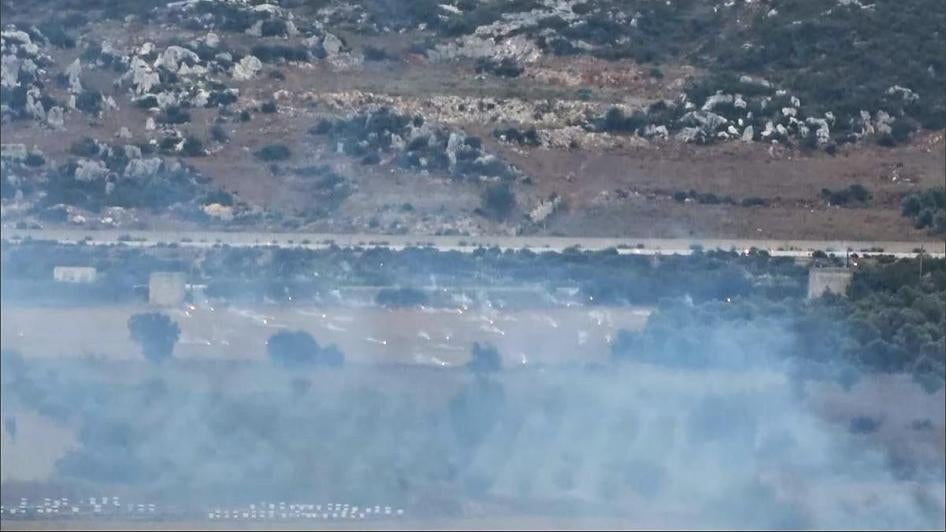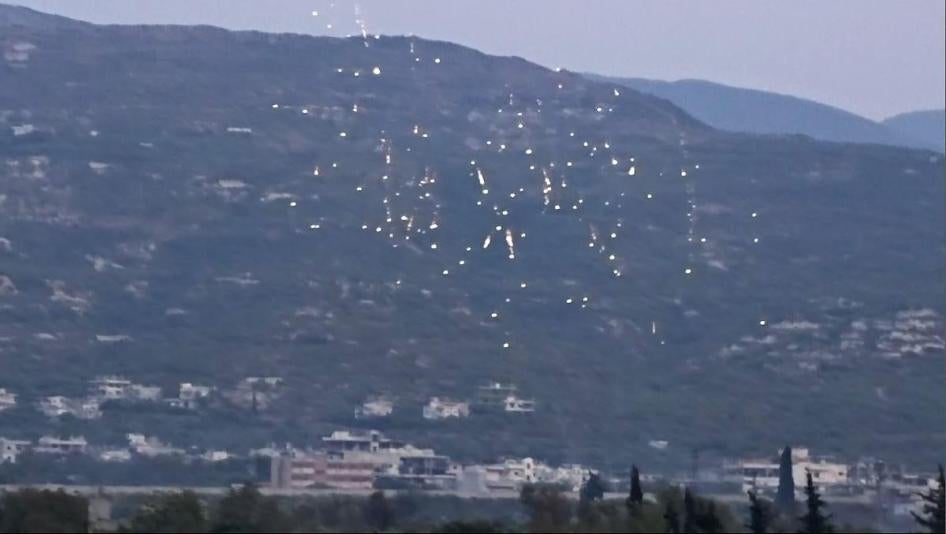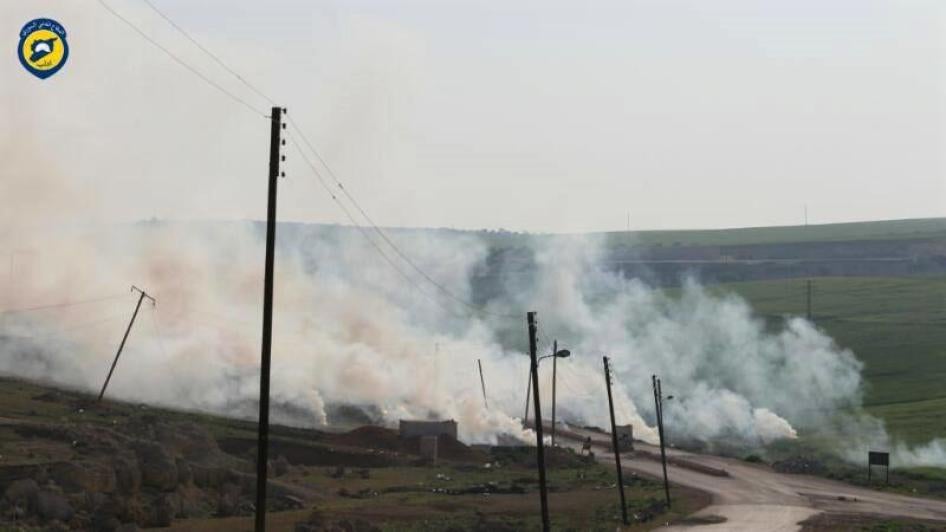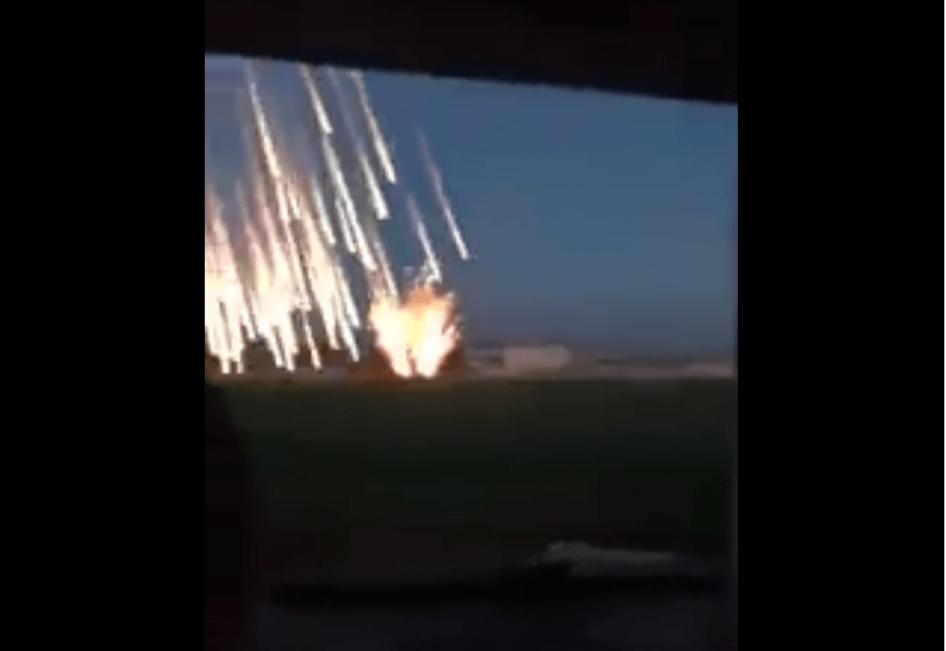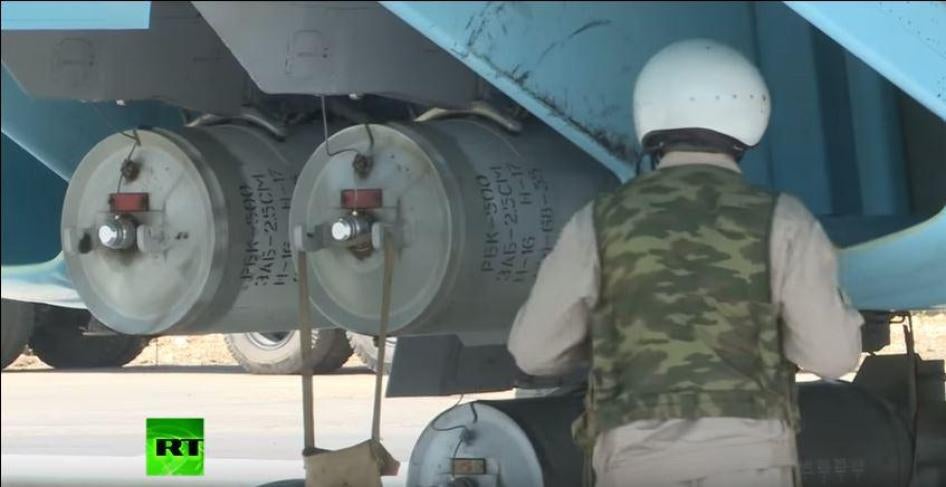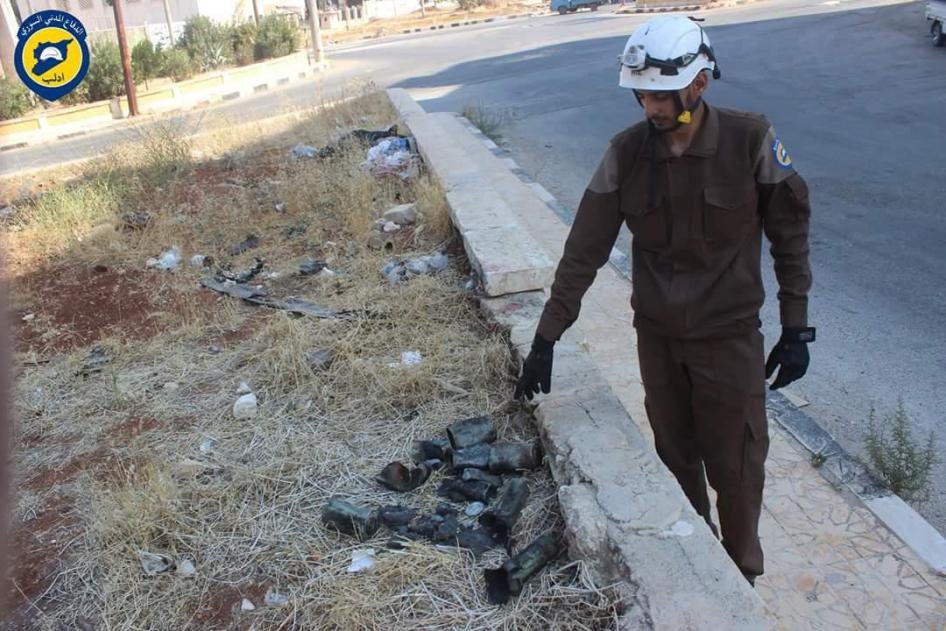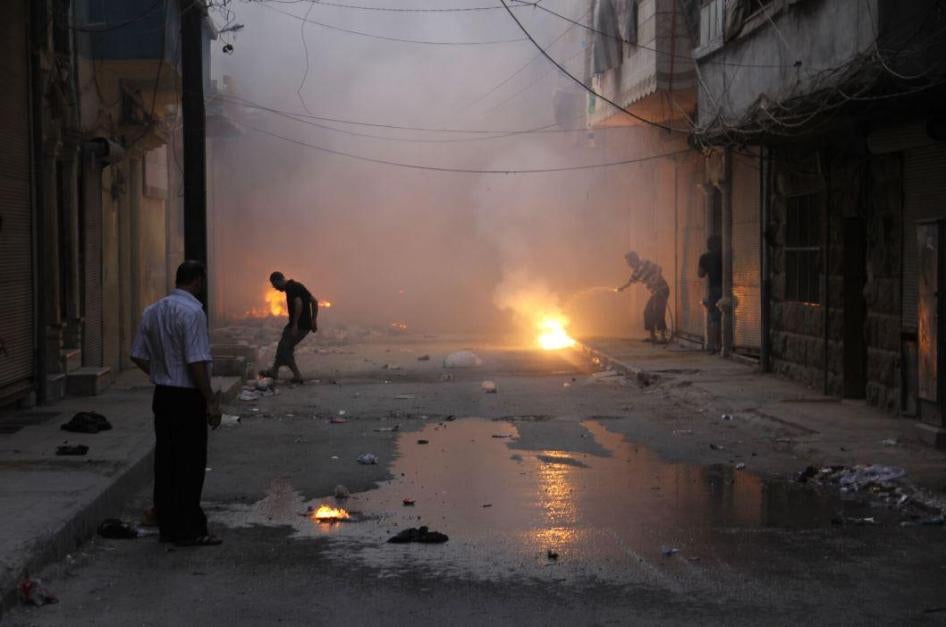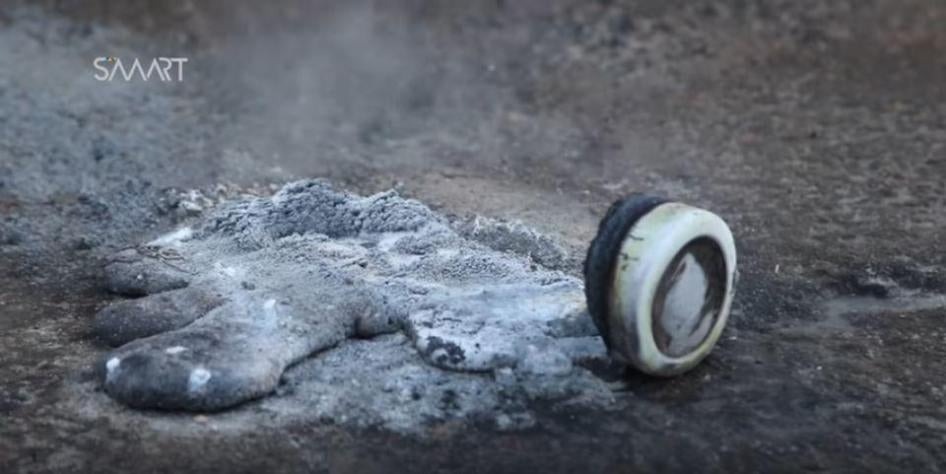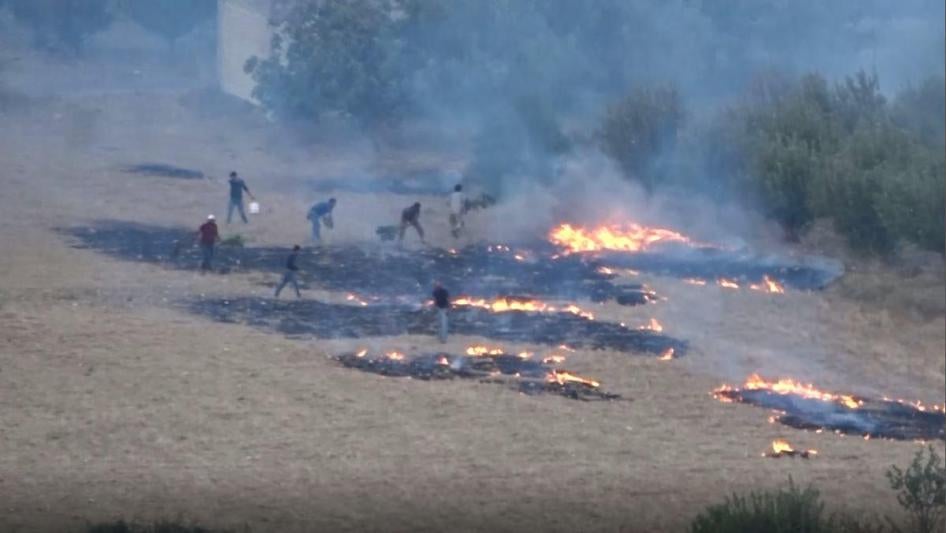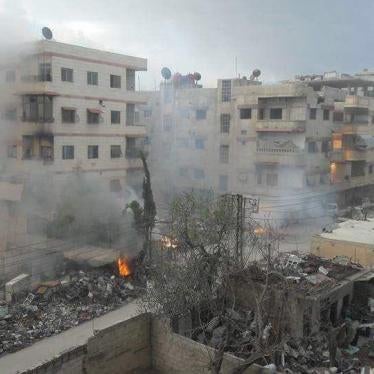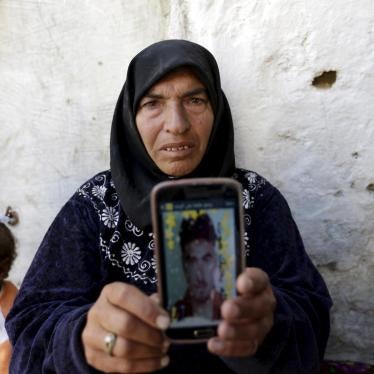Incendiary weapons are among the cruelest weapons used in contemporary armed conflict. These weapons, which produce heat and fire through the chemical reaction of a flammable substance, cause excruciating burns and destroy homes and other civilian structures. They are regulated by Protocol III to the Convention on Conventional Weapons (CCW), but that instrument has loopholes that reduce its legal and normative power.[1] CCW states parties have increasingly expressed support for revisiting and strengthening Protocol III, and they have set aside time at their annual Meeting of States Parties in November 2018 to address the topic.
Human Rights Watch and the Harvard Law School International Human Rights Clinic (IHRC) call on states to hold a robust exchange of views in November, and to dedicate additional time in 2019 for further discussions, possibly in the form of an informal meeting of experts. States should not only condemn ongoing use, but should also work toward closing Protocol III’s loopholes and building the stigma against incendiary weapons. A complete ban on incendiary weapons would have the greatest humanitarian benefits.
To bolster the case for reviewing and amending Protocol III, this paper rebuts common myths about incendiary weapons and the law that regulates them.
Myth #1: The harm caused by incendiary weapons is comparable to that of other conventional weapons.
Reality: Incendiary weapons inflict exceptionally cruel injuries, including horrific burns, which can produce immediate and long-term suffering and, in many cases, a painful death.
- Incendiary weapons can cause fourth- and fifth-degree burns that damage skin, muscles, ligaments, tendons, nerves, blood vessels, and even bones. Burns can also lead to severe infections and shock.[2]
- Victims face an excruciating treatment process. Dressings for burns must be changed daily and dead skin removed, a painful process that has been described as being “flayed alive.”[3]
- Incendiary weapons can also cause carbon monoxide poisoning and respiratory damage. Victims may be unable to breathe due to inflammation to the lungs or other tissues.
- Individuals who survive an initial attack often experience organ failure, lowered resistance to disease, lifelong disability, muscle weakness, and psychological trauma. Survivors sometimes find that they are also shunned due to severe scarring and disfigurement, which can drive them to withdraw from society.
- In addition to inflicting physical injury, incendiary weapons can cause socioeconomic harm and displacement because they destroy homes, hospitals, schools, farmland, and other civilian infrastructure.
Myth #2: Incendiary weapons are not a common tool in contemporary armed conflict.
Reality: Incendiary weapons have been used repeatedly in recent armed conflicts, most notably in Syria.
- Human Rights Watch documented 30 incidents involving incendiary weapons in Syria over the first seven months of 2018. The attacks, by the Syrian-Russian military alliance, took place in six governorates: Aleppo, Damascus, Damascus Countryside, Daraa, Hama, and Idlib. Syria Civil Defense reported that on March 16, 2018, an incendiary weapon attack on Kafr Batna, in Eastern Ghouta, killed at least 61 people and injured more than 200.[4]
- From November 2012 through 2017, Human Rights Watch documented more than 90 incendiary weapons attacks by the Syrian-Russian military alliance in Syria.[5] The total number of such attacks is likely higher because some attacks go unreported or are not recorded by visual media so cannot be investigated.
- Human Rights Watch documented use of incendiary weapons in Ukraine in July 2014, although it could not determine who fired the weapons.[6]
- White phosphorus munitions, which have comparable effects to incendiary weapons regulated under international law, have also been used repeatedly over the past 15 years, including by US-led coalition forces against the Islamic State in Iraq and Syria in 2017;[7] by Saudi Arabia-led coalition forces in Yemen in 2016;[8] by Israel in Gaza in 2008-2009;[9] by both the International Security Assistance Force and the Taliban in Afghanistan between 2005-2011;[10] by Ethiopian forces in Somalia in 2007,[11] and by the United States in Iraq in 2004.[12]
Myth #3: Existing international humanitarian law is adequate to protect civilians from incendiary weapons; preventing problematic use is a matter of compliance and universalization.
Reality: While states should join and comply with the Convention on Conventional Weapons, Protocol III governing incendiary weapons has two loopholes that interfere with its ability to protect civilians.
- Article 1 of Protocol III narrowly defines an incendiary weapon as “any weapon or munition primarily designed to set fire to objects or cause burn injury to persons….” This definition excludes multipurpose munitions, notably those containing white phosphorus, which set fire and cause burns but are “primarily designed” for other uses, such as marking, obscuring, or signaling.
- Article 2’s restrictions on use arbitrarily differentiate between incendiary weapons based on their delivery system. Article 2 comprehensively prohibits the use of air-dropped incendiary weapons in concentrations of civilians, but it allows the use of ground-launched incendiary weapons in concentrations of civilians when the military target is “clearly separated from the concentration of civilians and all feasible precautions are taken” to limit the incendiary effects and minimize injury or loss of life to civilians.
- The drafters of Protocol III focused on regulating the incendiary weapons most troubling at the time of its negotiation: air-dropped weapons specifically designed to burn and set fires, notably those containing napalm. This narrow scope, however, is a legacy of the 1970s and no longer appropriate today.[13]
Myth #4: Protocol III’s definition of incendiary weapons appropriately excludes multipurpose munitions that have only incidental incendiary effects.
Reality: By excluding multipurpose munitions, such as those containing white phosphorus, Protocol III fails to regulate munitions that cause the same harm in the same manner as those it defines as incendiary weapons.
- White phosphorus is a chemical substance that ignites when exposed to oxygen. The chemical reaction creates intense heat of about 815 degrees Celsius and produces light and a thick smoke.[14]
- White phosphorus munitions operate in the same way as the incendiary weapons covered by Protocol III: by setting fires and causing burns “through the action of flame, heat, or combination thereof, produced by a chemical reaction of a substance delivered on the target.” As noted above, they fall outside of Protocol III’s definition of incendiary weapons because they are “primarily designed” to be obscurants.
- White phosphorus causes severe thermal and chemical burns, often down to the bone, that are slow to heal and likely to develop infections. If not all fragments of white phosphorus are removed, they can exacerbate wounds after treatment and reignite when exposed to oxygen. White phosphorus burns on only 10 percent of the body are often fatal.
- In 2008-2009, for example, Israel’s use of white phosphorus munitions in Gaza killed at least 12 civilians and left dozens suffering from deep burns and respiratory damage.[15]
- The use of white phosphorus munitions between 2005 and 2011 in Afghanistan also severely burned civilians, including an eight-year-old girl, who went through fifteen surgeries due to the extensive burns on her face, head, neck, and arms. Her recovery period took a number of months because whenever doctors tried to “scrape the dead tissue, flames leapt out.” While she and five other family members ultimately survived the attack, two of her sisters died.[16]
Myth #5: Armed forces need white phosphorus munitions because of their effectiveness as obscurants.
Reality: The humanitarian harm caused by white phosphorus munitions outweighs their potential usefulness on the battlefield, and less dangerous alternatives exist.
- Protocol III should regulate white phosphorus munitions, despite claims about their military utility, because of the cruel and indiscriminate harm they cause. In the past, weapons that inflict unacceptable harm, such as antipersonnel landmines and cluster munitions, have been banned or regulated regardless of purported military benefits.
- In addition, there are alternative obscurants to white phosphorus munitions, such as 155mm smoke projectiles, which produce comparable visual screening properties without destructive incendiary effects.[17]
- Some states have already turned to such alternatives in response to public pressure. While Israel used white phosphorus munitions in Gaza in 2008-2009, it began developing alternative smoke shells after it was widely condemned for the harm its munitions caused. There have been no reports of Israeli use of white phosphorus in Gaza since 2009, although it has conducted further military operations there.[18]
Myth #6: Protocol III’s distinction between air-dropped and ground-launched incendiary weapons reflects meaningful differences based on the types of delivery mechanism and frequency of use.
Reality: The distinction between air-dropped and ground-launched incendiary weapons is arbitrary because they cause the same type and magnitude of harm and have both been used in recent conflicts.
- The delivery system of an incendiary weapon is irrelevant because the nature and extent of harm is the same. An individual will suffer cruel injury regardless of how the incendiary warhead reached them. Protocol III itself states that all incendiary weapons “set fire to objects or … cause burn injury to persons.”
- Both air-dropped and ground-launched incendiary weapons have been used in populated areas in recent conflicts. In 2017, most of the 22 incendiary weapons attacks that Human Rights Watch documented in Syria involved air-dropped models.[19] In 2018, Human Rights Watch documented that the Syrian-Russian military alliance used ground-launched incendiary Grad rockets in at least 20 instances and air-dropped incendiary weapons in at least 10 instances.[20]
- Ground-launched incendiary weapons, in particular 9M22S Grad rockets, were also used in July-August 2014 in at least two towns in Ukraine, Ilovaisk and Luhansk. They burned several homes and endangered civilians.[21]
- Because they generally lack aircraft to drop incendiary weapons, non-state armed groups are more likely to have access to ground-launched models. For example, the US military reported 11 cases from 2007-2009 in which insurgents used white phosphorus delivered by rockets or mortars in Afghanistan.[22]
Myth #7: Amending Protocol III would be complicated and time consuming.
Reality: Strengthening Protocol III, which requires only small changes to the text, would be legally and procedurally straightforward.
- Expanding Article 1 to cover multipurpose munitions with incidental incendiary effects would simply require shifting from a design-based to an effects-based definition. The language could be changed to “any weapon or munition that has the effect of setting fire to objects or causing burn injury to persons….”
- Precedent for adopting an effects-based weapons definition exists in CCW Protocol I on Non-Detectable Fragments,[23] Additional Protocol I to the Geneva Conventions,[24] and the Nuclear Weapons Advisory Opinion issued by the International Court of Justice.[25] Each of these documents looks to the effects of particular types of weapons in order to determine their legality.[26]
- Strengthening restrictions on use would simply require eliminating the distinction in Article 2 between delivery systems. Article 2(2) could be amended to remove “air-delivered,” so that it prohibits making “any military objective located within a concentration of civilians the object of attack by incendiary weapons.” Article 2(3) could then be deleted.
- Treaties regulating conventional weapons generally do not distinguish based upon delivery system. For example, Amended Protocol II to the CCW, which covers mines, booby-traps, and other devices, defines a “remotely-delivered mine” as a mine “delivered by artillery, missile, rocket, mortar, or similar means, or dropped from an aircraft.”[27]
- The process to amend Protocol III could be similarly straightforward and completed in a timely manner. States should set aside time to review Protocol III in 2019 and then agree to a negotiating mandate with the goal of strengthening the protocol the following year.
Myth #8: States are resistant to amending Protocol III.
Reality: Growing state support for strengthening the law and condemnation of recent use demonstrates the time is ripe for CCW states parties to revisit Protocol III.
- Since 2010, at least 35 states, along with other international actors including the International Committee of the Red Cross (ICRC) and the UN secretary-general, have publicly recognized the problems of incendiary weapons.[28]
- In November 2017, CCW states parties engaged in particularly robust discussions when the topic became a separate agenda item at their annual meeting. Almost all of the 26 states that spoke expressed concerns about incendiary weapons, and the majority recommended CCW states parties take some action in response.
- At least nine states supported amending Protocol III.[29] For example, Costa Rica described ongoing use of incendiary weapons as an “alert” to evaluate and expand the scope of Protocol III. Austria said it “continues to see value in strengthening Protocol III,”[30] while Chile promised to work with “like-minded States and civil society in order to bring about an effective prohibition of this type of weapon and to strengthen Protocol III.”[31]
- At least 13 states called for further discussions on Protocol III.[32] For example, the Holy See urged “[a]n honest technical and legal review of the provisions.”[33] Croatia stated, “[T]he time is right to discuss the relevance of standards set by Protocol III,”[34] while the Philippines agreed that “review and reflection is timely and consistent with the objective of keeping the convention and its protocols relevant.”[35
- Switzerland proposed an informal meeting of experts regarding Protocol III.[36] While this proposal was ultimately blocked by a few states parties, at least five states expressly supported it.[37]
- At least 17 states plus the European Union condemned or expressed concerns about reports of recent and ongoing use of incendiary weapons in concentrations of civilians at the CCW’s annual meeting in 2017.[38] For example, Zambia “condemn[ed] in the strongest terms the use of incendiary weapons in populated areas regardless of the method of deployment.”[39] The United States said it was “deeply concerned over the continued reports of air-delivered incendiary weapons being used in areas near civilians,”[40] while Ireland described such reports as “disturbing.”[41]
- Final reports from CCW annual meetings, which are adopted by consensus, have noted concerns regarding incendiary weapons with increasing urgency since 2011.[42] At the end of the CCW’s 2017 Meeting of States Parties, the final report “condemned any use of incendiary weapons against civilians or civilian objects, and any other use incompatible with the relevant rules of international humanitarian law, including the provisions of Protocol III where applicable.”[43]
Myth #9: CCW states parties should not make Protocol III a priority for discussion because attention would be better spent on tackling new issues than revisiting agreed-on protocols.
Reality: CCW states parties should prioritize revisiting and strengthening Protocol III because the convention is intended to be a living document and states parties have not revisited Protocol III since it was adopted in 1980.
- At the 2017 Meeting of States Parties, several CCW states parties remarked that a review of Protocol III was long overdue. While, in the words of Costa Rica, the CCW was designed to be “a convention that is dynamic and flexible,”[44] Protocol III has remained static for almost four decades.
- States parties have, by contrast, expanded and strengthened other elements of the convention and its three original protocols several times since adoption. States parties have amended Protocol II, added two new protocols, and expanded the scope of the convention to encompass non-international armed conflicts.[45]
- Work on incendiary weapons need not distract from progress on lethal autonomous weapons systems because states parties to the CCW have demonstrated their ability to work on multiple issues at the same time. For example, while states parties were negotiating Protocol IV on blinding laser weapons in 1995, they were also amending Protocol II. In 2003, states parties both adopted Protocol V on explosive remnants of war and agreed to a political commitment on mines other than antipersonnel mines.[46]
- The evidence of ongoing use of incendiary weapons and growing calls for a response underscore the urgency of revisiting Protocol III.
Myth #10: Amending Protocol III will not have a significant impact.
Reality: Closing the loopholes in Protocol III will better protect civilians by more strictly regulating states parties’ use of incendiary weapons and by creating a more powerful norm against their use.
- A stronger protocol would bind states parties, meaning they could not lawfully engage in use that falls into the current loopholes. Eliminating ambiguity in Protocol III would also facilitate enforcement because with clearer rules, breaches are easier to recognize and condemn.
- Strengthening Protocol III could also influence the conduct of actors not bound by its provisions by increasing the stigma against incendiary weapons. Stigmatization has already contributed to changes in domestic policies. For example, growing opposition to incendiary weapons, at the international and national levels, helped pressure Israel, which is not party to Protocol III, to alter its policies on white phosphorus in 2013 in order to dramatically restrict use.[47]
- Stigmatization can also influence the conduct of non-state armed groups, especially those that seek to be viewed as responsible actors.
Annex I. Relevant Publications
A series of reports published over the past decade by Human Rights Watch and the Harvard Law School International Human Rights Clinic (IHRC) examine the issue of incendiary weapons in more depth. Approaching the topic from a variety of angles, these reports make the case that existing international law is inadequate and should be strengthened. The reports also provide annual updates of the use of incendiary weapons and the evolution of government positions.
To download the full reports, please visit: https://goo.gl/yHJQC8
An Overdue Review: Addressing Incendiary Weapons in the Contemporary Context
November 2017
This 30-page report examines how the outdated regulations of Protocol III reflect concerns about incendiary weapons use at the time of the protocol’s negotiation. It argues that the law must evolve to respond to a changed military and political landscape.
Time to Act against Incendiary Weapons
December 2016
This 32-page report highlights the urgency of action at the CCW’s Fifth Review Conference and calls on states to set aside time to revisit Protocol III.
From Condemnation to Concrete Action: A Five-Year Review of Incendiary Weapons
November 2015
This 27-page report analyzes the past five years of the incendiary weapons debate. It also discusses recent use of incendiary weapons in Syria and Ukraine, allegations of use in Libya and Yemen, and the evolution of national views on Protocol III.
Incendiary Weapons: Recent Use and Growing Opposition
November 2014
This 16-page report details the latest harm caused by incendiary weapons in Syria and Ukraine while showing the influence of growing stigma on the practice of states, such as Israel.
Syria’s Use of Incendiary Weapons*
November 2013
This 25-page report documents new use of incendiary weapons in Syria and the civilian harm that resulted.
Government Positions on Protocol III on Incendiary Weapons
November 2012
This 18-page report updates an April 2012 report on countries’ views of Protocol III.
Incendiary Weapons: Government Positions and Practices
April 2012
This 22-page report analyzes government statements on Protocol III and provides evidence of the use, production, and stockpiling of incendiary weapons, including white phosphorous.
Q&A on Incendiary Weapons and CCW Protocol III
November 2011
This 3-page Q&A defines incendiary weapons, describes the harms they cause, lays out the shortcomings of Protocol III, and offers ways to strengthen the law.
Strengthening the Humanitarian Protections of Protocol III on Incendiary Weapons
August 2011
This 15-page report urges state parties to discuss Protocol III at the CCW’s Fourth Review Conference and proposes specific amendments to close its loopholes. The report argues that a blanket prohibition of incendiary munitions would most effectively protect civilians.
The Human Suffering Caused by Incendiary Munitions
March 2011
This 16-page report details the horrific harms caused by incendiary weapons, including napalm and white phosphorous, and provides a history of use since states adopted Protocol III.
The Need to Re-Visit Protocol III on Incendiary Weapons
November 2010
This 10-page report introduces the inadequacies of Protocol III and calls on states parties to revisit the protocol. It also examines how the US reservation has exacerbated the protocol’s shortcomings and hindered its ability to build norms.
Rain of Fire: Israel’s Unlawful Use of White Phosphorus in Gaza*
March 2009
This 71-page report, based on an in-depth field investigation, documents Israel’s use of white phosphorus during its 2009 military operations in Gaza.
*Unless noted by an asterisk, Human Rights Watch published these reports jointly with IHRC.
[1] Convention on Conventional Weapons (CCW) Protocol III on Incendiary Weapons (Protocol III), adopted October 10, 1980, entered into force December 2, 1983.
[2] For more information on the suffering caused by incendiary weapons, see Human Rights Watch and the Harvard Law School International Human Rights Clinic (IHRC), Memorandum to Convention on Conventional Weapons Delegates: The Human Suffering Caused by Incendiary Munitions, March 2011, https://www.hrw.org/news/2011/03/31/human-suffering-caused-incendiary-munitions, p. 3.
[3] Denise Chong, The Girl in the Picture: The Story of Kim Phuc, the Photograph, and the Vietnam War (New York: Penguin Group, 1999), p. 94.
[4] Syria Civil Defense, “A horrific massacre including unconscienable [sic] Napalm air strikes killed at least 61 civilians in #Kafr_Bata Town,” Twitter, March 16, 2018, https://twitter.com/SyriaCivilDef/status/974660689502629889 (accessed October 21, 2018).
[5] Human Rights Watch documented more than 68 incendiary weapons attacks from November 2012 to 2016, and 22 attacks in 2017. Human Rights Watch and IHRC, An Overdue Review: Addressing Incendiary Weapons in the Contemporary Context, November 2017, https://www.hrw.org/news/2017/11/20/overdue-review-addressing-incendiary-weapons-contemporary-context, pp. 14-15. A YouTube video, published by Russia Today in June 2016, showed a Russian aircraft with incendiary bombs at Russia’s airbase in Syria, suggesting that Russia has also been using incendiary weapons in Syria. Mary Wareham, “Incendiary Weapons Pose Civilian Threat in Syria,” Human Rights Watch dispatch, June 21, 2016, https://www. hrw.org/news/2016/06/21/dispatches-incendiary-weapons-pose-civilian-threat-syria.
[6] Human Rights Watch and IHRC, Incendiary Weapons: Recent Use and Growing Opposition, November 2014, https://www.hrw.org/news/2014/11/10/incendiary-weapons-recent-use-and-growing-opposition, p. 6; Yuri Lyamin and Michael Smallwood, “9M22S Incendiary Rocket Components Documented in Eastern Ukraine,” post to “The Hoplite” (blog), Armament Research Services, October 14, 2014, http://armamentresearch.com/9m22s-incendiary-rocket-components-documented-in-eastern-ukraine/ (accessed October 21, 2018).
[7] “Iraq/Syria: Danger from US White Phosphorus,” Human Rights Watch news release, June 14, 2017, https://www.hrw.org/news/2017/06/14/iraq/syria-danger-us-white-phosphorus.
[8] Thomas Gibbons-Neff, “Saudi Arabia Appears to be Using U.S.-Supplied White Phosphorus in its War in Yemen,” Washington Post, September 19, 2016, https://www.washingtonpost.com/news/checkpoint/ wp/2016/09/19/saudi-arabia-appears-to-be-using-u-s-supplied-white-phosphorus-in-its-war-in-yemen/?utm_term=.fd4007f43775 (accessed October 21, 2018).
[9] Human Rights Watch, Rain of Fire: Israel’s Unlawful Use of White Phosphorus in Gaza, March 2009, https://www.hrw.org/report/2009/03/25/rain-fire/israels-unlawful-use-white-phosphorus-gaza.
[10] C.J. Chivers, “10 Years into Afghan War, a Thunderous Duel,” New York Times, October 7, 2011, https://www.nytimes.com/2011/10/08/world/asia/attacks-rock-us-outposts-near-afghanistan-pakistan-border.html (accessed October 21, 2018); Charlotte Aagaard, “Leaked Documents Show NATO Use of White Phosphorous against Afghan Insurgents,” Dagbladet information (Denmark), April 19, 2011, http://www.information.dk/265810 (accessed October 21, 2018). For further discussion of Taliban use, attempted use, and storage of white phosphorus, see “Reported Insurgent White Phosphorus Attacks and Caches,” US Central Command press release, 20090511–002, May 12, 2009, http://www.centcom.mil/MEDIA/PRESS-RELEASES/Press-Release-View/Article/903751/reported-insurgent-white-phosphorus-attacks-and-caches/ (accessed October 21, 2018).
[11] The Ethiopian government denied having used white phosphorus. See Monitoring Group on Somalia, “Report of the Monitoring Group on Somalia pursuant to Security Council resolution 1724 (2006),” S/2007/436, July 18, 2007, http://www.un.org/ga/search/view_doc.asp?symbol=S/2007/436 (accessed October 21, 2018), paras. 30-34.
[12] Andrew Buncombe and Solomon Hughes, “The Fog of War: White Phosphorus, Fallujah, and Some Burning Questions,” The Independent, November 15, 2005, https://www.independent.co.uk/news/world/americas/the-fog-of-war-white-phosphorus-fallujah-and-some-burning-questions-5348984.html (accessed October 21, 2018).
[13] Human Rights Watch and IHRC, An Overdue Review, pp. 11-12.
[14] For more information on white phosphorus and its effects, see Human Rights Watch and IHRC, From Condemnation to Concrete Action: A Five-Year Review of Incendiary Weapons, November 2015, https://www.hrw.org/sites/default/files/supporting_resources/incendiaries-5_year_review-final_0.pdf, pp. 4-5.
[15] Human Rights Watch, Rain of Fire, pp. 3-4.
[16] Jason Straziuso and Evan Vucci, “Burned Afghan Girl Learns to Smile Again,” Associated Press, June 23, 2009,
http://www.nbcnews.com/id/31509214/ns/world_news-south_and_central_asia/t/burned-afghan-girl-learns-smile-again/#.W81QSEtKhPZ (accessed October 21, 2018). It is unclear which parties used white phosphorus munitions in this particular incident. The US military documented 44 alleged uses by the Taliban. The spokesman for the commander of NATO and US troops in Afghanistan, Brig. Gen. Richard Blanchette, however, told Human Rights Watch that NATO and US forces also used white phosphorus munitions in Afghanistan. See “Taleban ‘Used White Phosphorus,’” BBC, May 11, 2009, http://news.bbc.co.uk/2/hi/8045012.stm (accessed October 21, 2018); “Afghanistan: NATO Should ‘Come Clean’ on White Phosphorus,” Human Rights Watch news release, May 8, 2009, https://www.hrw.org/news/2009/05/08/afghanistan-nato-should-come-clean-white-phosphorus.
[17] Human Rights Watch, Rain of Fire, p. 4.
[18] “Israel: Strengthen White Phosphorus Phase-Out,” Human Rights Watch news release, May 18, 2013, https://www.hrw.org/news/2013/05/18/israel-strengthen-white-phosphorus-phase-out; Gili Cohen, “IDF to Stop Using Shells with White Phosphorus in Populated Areas, State Tells High Court,” Haaretz, May 13, 2013, https://www.haaretz.com/.premium-white-phosphorus-ban-in-towns-1.5242691.
[19] Human Rights Watch, An Overdue Review, p. 14.
[20] Human Rights Watch, “Incendiary Weapons,” in Reaching Critical Will, First Committee Briefing Book, 2018, http://reachingcriticalwill.org/images/documents/Disarmament-fora/1com/1com18/briefingbook/FCBB-2018-incendiary.pdf (accessed October 30, 2018), p. 25.
[21] Human Rights Watch and IHRC, Incendiary Weapons: Recent Use and Growing Opposition, p. 6.
[22] “Reported Insurgent White Phosphorus Attacks and Caches,” US Central Command press release.
[23] CCW Protocol I on Non-Detectable Fragments (Protocol I), adopted October 10, 1980, 1342 U.N.T.S. 168, entered into force December 2, 1983 (“It is prohibited to use any weapon the primary effect of which is to injure by fragments which in the human body escape detection by X-rays.” (emphasis added)).
[24] Additional Protocol I to the Geneva Conventions prohibits the use of weapons “of a nature to cause superfluous injury or unnecessary suffering.” Protocol Additional to the Geneva Conventions of August 12, 1949, and Relating to the Protection of Victims of International Armed Conflicts (Additional Protocol I), adopted June 8, 1977, 1125 U.N.T.S. 3, entered into force December 7, 1978, art. 35(2) (emphasis added). That protocol additionally forbids attacks using “means of combat the effects of which cannot be limited as required by this Protocol.” Ibid., art. 51(4)(c) (emphasis added).
[25] Advisory Opinion on the Legality of the Threat or Use of Nuclear Weapons, International Court of Justice (ICJ) Reports 226, July 8, 1996, https://www.icj-cij.org/files/case-related/95/095-19960708-ADV-01-00-EN.pdf (accessed October 21, 2018), para. 55 (noting that whether a weapon violated the prohibitions on poison or asphyxiating weapons depends on whether the weapon’s “prime, or even exclusive, effect is to poison or asphyxiate”) (emphasis added).
[26] The 2008 Convention on Cluster Munitions demonstrates how even a convention with a design-based definition can take effects into account. The convention defines cluster munition as being “designed to disperse or release explosive submunitions….” but looks to the humanitarian effects of weapons to determine which are safe to exclude. It states that its definition of cluster munition does not include munitions with certain specific technical characteristics because they “avoid indiscriminate area effects and the risks posed by unexploded submunitions.” Convention on Cluster Munitions, adopted May 30, 2008, Diplomatic Conference for the Adoption of a Convention on Cluster Munitions, CCM/77, entered into force August 1, 2010, art. 2(2)(c) (emphasis added).
[27] CCW Protocol II on Prohibitions or Restrictions on the Use of Mines, Booby-Traps and other Devices, as amended on May 3, 1996 (Amended Protocol II), adopted May 3, 1996, entered in force December 3, 1998, art. 2(2).
[28] Human Rights Watch and IHRC, An Overdue Review, p. 21.
[29] Argentina, Austria, Chile, Costa Rica, the Holy See, Jordan, Mexico, Panama, and Zambia. For these statements and all audio recordings referenced below, see UN Office at Geneva (UNOG), Meeting of High Contracting Parties to the CCW, Geneva, November 23, 2017, https://conf.unog.ch/digitalrecordings/# (accessed October 21, 2018) (audio recording).
[30] Statement of Austria, Meeting of High Contracting Parties to the CCW, Geneva, November 23, 2017, p. 1.
[31] Statement of Chile, Meeting of High Contracting Parties to the CCW, Geneva, November 23, 2017 (audio recording).
[32] Argentina, Austria, Chile, Costa Rica, Croatia, the Holy See, Ireland, Mexico, New Zealand, Panama, the Philippines, Switzerland, and Zambia. See UNOG, Meeting of High Contracting Parties to the CCW, Geneva, November 23, 2017 (audio recording).
[33] Statement of the Holy See, Meeting of High Contracting Parties to the CCW, Geneva, November 22, 2017, p. 2.
[34] Statement of Croatia, Meeting of High Contracting Parties to the CCW, Geneva, November 23, 2017, p. 1.
[35] Statement of the Philippines, Meeting of High Contracting Parties to the CCW, Geneva, November 23, 2017 (audio recording).
[36] Switzerland proposed that the Meeting of High Contracting Parties decide “to convene an informal meeting of experts to discuss issues related to the universalization and implementation of the Protocol III in light of the humanitarian concerns expressed.” Statement of Switzerland, Meeting of High Contracting Parties to the CCW, Geneva, November 23, 2017, p. 2.
[37] Austria, Croatia, Ireland, Mexico, and New Zealand. See UNOG, Meeting of High Contracting Parties to the CCW, Geneva, November 23, 2017 (audio recording).
[38] Austria, Chile, Costa Rica, Croatia, Germany, the Holy See, Ireland, Jordan, Mexico, New Zealand, Panama, the Philippines, Sri Lanka, Switzerland, United Kingdom, United States, Zambia, and the European Union. Ibid.
[39] Statement of Zambia, Meeting of High Contracting Parties to the CCW, Geneva, November 23, 2017 (audio recording).
[40] Statement of the United States, Meeting of High Contracting Parties to the CCW, Geneva, November 23, 2017 (audio recording).
[41] Statement of Ireland, Meeting of High Contracting Parties to the CCW, Geneva, November 23, 2017 (audio recording).
[42] For more on the final reports’ language on incendiary weapons, see Human Rights Watch and IHRC, An Overdue Review, p. 24.
[43] Meeting of the High Contracting Parties to the CCW, Final Report, CCW/MSP/2017/8, December 11, 2017, https://www.unog.ch/80256EDD006B8954/(httpAssets)/8A3BE602D1E4142CC12581E70054D0F4/$file/CCW_MHCP+2017_FinalReport_Advance+Version+(003)_ES.pdf (accessed November 12, 2018), para. 35.
[44] Statement of Costa Rica, Meeting of High Contracting Parties to the CCW, Geneva, November 23, 2017 (audio recording).
[45] United Nations Office at Geneva, “Convention on Conventional Weapons,” https://www.unog.ch/80256EE600585943/(httpPages)/4F0DEF093B4860B4C1257180004B1B30?OpenDocument, (accessed October 21, 2018).
[46] Ibid.
[47] “Israel: Strengthen White Phosphorus Phase-Out,” Human Rights Watch news release; Cohen, “IDF to Stop Using Shells with White Phosphorus in Populated Areas,” Haaretz.
